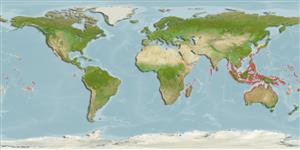Common names from other countries
Environment: milieu / climate zone / depth range / distribution range
ນິເວດວິທະຍາ
ສັດທະເລ; ນ້ຳຈືດ; ນ້ຳກ່ອຍ ກ່ຽວກັນຫີນ; ປາທີ່ມີການເຄື່ອນຍ້າຍຈາກທະເລໄປຫານ້ຳຈືດ ແລະນ້ຳຈືດຫາທະເລ (Ref. 46888); ລະດັບຄວາມເລິກ 0 - 1 m (Ref. 86942). Tropical
Indo-Pacific: along East African coast, from Zululand in South Africa northwards to the Red Sea and most of West Indian Ocean islands (Ref. 4756); further east to the Marianas and Samoa; north to Ryukyu Islands, south to western Australia and Oceania (Ref. 2334).
Length at first maturity / ຂະໜາດ / ນ້ຳໜັກ / Age
Maturity: Lm 5.0 range ? - ? cm
Max length : 19.0 cm TL ຕົວຜູ້/ບໍ່ມີເພດ; (Ref. 4756)
ຄີ (ໜາມ)ແຂງຢູ່ຫຼັງປາ (ທັງໝົດ) : 12 - 18; ຄີຫຼັງຂອງປາ (ຄີອ່ອນ) (ທັງໝົດ) : 9 - 12; ຄີ(ໜາມ) ແຂງຢູ່ຄີກົ້ນປາ
ກຸ່ມປາກະດູກແຂງ
ຄວາມຖີ່ຂອງກຸ່ມຖ່າຍທອດພັນ
ປາທີ່ມີການເຄື່ອນຍ້າຍຈາກທະເລໄປຫານ້ຳຈືດ ແລະນ້ຳຈືດຫາທະເລ
ປາທີ່ມີການເຄື່ອນຍ້າຍຈາກທະເລແລະໄປໄຂ່ຢູ່ນ້ຳຈືດ
ຄີກົ້ນຂອງປາ
ສັດທີ່ມີກະດູກສັນຫັຼງ
ການຖ່າຍທອດທາງກຳມະພັນຈາກພໍ່ແມ່ຫາລູກ: 1; ຄີກົ້ນຂອງປາ: 8 - 11. Diagnosis: Distinguished by the following characteristics: pelvic fins lacking frenum; little or no membrane uniting medial most pelvic rays; first dorsal fin height moderate, its margin usually convex, occasionally straight, with a black stripe inframarginally and numerous small, white spots posteriorly on fin, no elongate spines; second dorsal fin with single, dusky stripe mesially; dorsal fins not connected by membrane; first dorsal fin with 11-16 spines; longitudinal scale count 64-100; head width 14.3-22.6% of standard length; pelvic fin length 11.3-15.2% of standard length; length of anal fin base 14.0-19.4% of standard length; length of second dorsal-fin base 17.6-23.7% of standard length; total D2 elements 10-13; total anal fin elements 9-12; TRDB 18-26 (Ref. 5218).
Facultative air-breathing (Ref. 126274); A resident intertidal species with homing behavior (Ref. 32612, 48637) and amphibious air-breather (Ref. 31184, 79840), found in brackish mud flats in mangrove and nipa palm areas. Found in both littoral and estuarine; able to climb out of water, in mangrove swamps and burrowing into intertidal mud banks (Ref. 4756). Occasionally in the lower parts of freshwater streams (Ref. 2847, 44894, 48637, 79840). Actively shuttling back and forth between rock pools and air (Ref. 31184). It feeds on worms, crustaceans, and insects (Ref. 37816). Can stay out of the water for up to 37 h if kept moist (Ref. 51276).
Life cycle and mating behavior
Maturities | ການສືບພັນ | Spawnings | Egg(s) | Fecundities | ຕົວອ່ອນ
Murdy, E.O., 1989. A taxonomic revision and cladistic analysis of the oxudercine gobies (Gobiidae: Oxudercinae). Rec. Aust. Mus., Suppl. 11:1-93. (Ref. 5218)
IUCN Red List Status (Ref. 130435)
CITES (Ref. 128078)
Not Evaluated
Threat to humans
Harmless
Human uses
ການປະມົງ: ທີ່ບໍ່ມີຄວາມສົນໃຈ; ຕູ້ປາ: ເປັນສີນຄ້າ
ເຄື່ອງມື
Special reports
Download XML
ແຫຼ່ງອີນເຕີເນັດ
Estimates based on models
Preferred temperature (Ref.
115969): 24.2 - 29.3, mean 28.4 (based on 2897 cells).
Phylogenetic diversity index (Ref.
82804): PD
50 = 0.5000 [Uniqueness, from 0.5 = low to 2.0 = high].
Bayesian length-weight: a=0.01072 (0.00495 - 0.02318), b=2.97 (2.79 - 3.15), in cm Total Length, based on LWR estimates for this Genus-body shape (Ref.
93245).
ຊັ້ນເຂດຮ້ອນ (Ref.
69278): 3.3 ±0.40 se; based on food items.
ຄວາມຢືດຢຸ່ນ (Ref.
120179): ສູງ, ປະຊາກອນຕຳ່ສຸດທີ່ໃຊ້ເວລາສອງໜ້ອຍກວ່າ 15 ເດືອນ (Preliminary K or Fecundity.).
Fishing Vulnerability (Ref.
59153): Low vulnerability (10 of 100).
